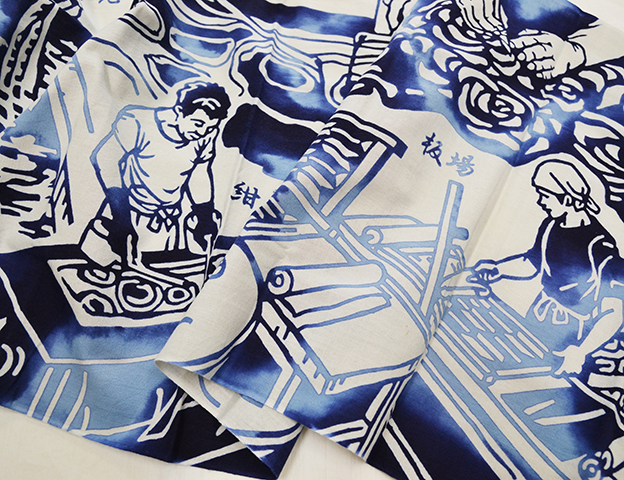Tokyo Honzome Chusen (Dyeing)

Tokyo Honzome Chusen is a type of stencil dyeing that has its origins in ''pouring dyeing'', a method of dying hand towels devised by Edo dyers at the end of the Edo period. The early stages of the technique seem to have been established by the mid-19th century. Since the end of the Meiji period in Tokyo, Chusen has been applied to yukata fabrics and the technique has been refined. Since the dye is poured onto both sides of the fabric, which has been shaped equally, it is dyed on both sides with both precision and a deep sense of fluctuation. Today, its uses have expanded to include hand towels and yukata, as well as accessories, clothes, and interior goods.
Feature
It is said that the origin of Chusen in Tokyo is that a dyer in Fukagawa devised the method of pouring indigo over a molded towel in order to dye tenugui, which had a lot of white material that was difficult to dye with regular indigo.
In the early to mid-19th century, coinciding with the appearance of pour-dyeing using indigo, tenugui navy blue shops (later known as the pour-dye industry) gathered in Kanda, and a culture developed in which tenugui were custom-dyed with creative designs to be handed out by entertainers and hobbyists.
During the Meiji period, the technique of ``chusen'' was developed in Osaka and continues to this day, and later spread to Tokyo. Chusen began with hand towels, but the application of Chusen to yukata fabric was started in Osaka, and at the end of the Meiji period, Chusen yukata fabric began to be dyed in Tokyo as well.
Since the Edo period in Tokyo, yukata have been dyed using a precise double-sided dyeing technique known as nagaita nakagata, so we have pursued this technique in chezome, and are good at crisp, detailed patterns, delicate differences, shading, and Hosokawa dyeing. Chusen in Tokyo, which values painstaking handwork, has been called ``honzome'' since the early Showa period, and the playfulness and craftsmanship of the Edo period has been inherited to this day.
How to make
The pattern paper stretched on the formwork is lowered onto the fabric and the resist dyeing paste is applied with a spatula. By folding the fabric exactly over the edge where the glue was placed and repeating the stamping process, the resist glue will be applied equally to both sides of the fabric.
The fabric is shaped several times at a time, and dyed by pouring the dye in a kettle with a long, narrow mouth onto the folded fabric. Turn the whole thing over and pour the dye from the back as well.
Dyeing techniques include ''one-color dyeing,'' ''differential dyeing,'' which dyes multiple colors at once, ''bokashi dyeing,'' which blends different colors of dye together, and ''Hosokawa dyeing,'' which dyes in layers. In the case of differences, we use a paste tube to create a dike of resist-dye paste on parts of the Hosokawa River, and when dyeing detailed patterns, we use a ''poke stick'' to carefully dye. The dyed fabric is washed with water and dried in the sun.

